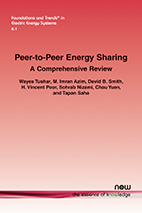Peer-to-Peer Energy Sharing: A Comprehensive Review
By Wayes Tushar, The University of Queensland, Australia, w.tushar@uq.edu.au | Sohrab Nizami, The University of Queensland, Australia, s.nizami@uq.edu.au | M. Imran Azim, Monash University, Australia, imran.azim@monash.edu | Chau Yuen, Singapore University of Technology and Design (SUTD), Singapore, yuenchau@sutd.edu.sg | David B. Smith, CSIRO Data61, Australia, David.Smith@data61.csiro.au | Tapan Saha, The University of Queensland, Australia, saha@itee.uq.edu.au | H. Vincent Poor, Princeton University, USA, poor@princeton.edu
Abstract
As the world is planning for a future with low carbon emissions, today’s power system is transitioning from its existing traditional hierarchical structure to a more decentralized framework through innovative energy management techniques, such as peer-to-peer (P2P) sharing. Due to the potential benefits that P2P sharing can offer to electricity prosumers, consumers, and the grid, research, development, and pilot trials of P2P are advancing rapidly. To capture these developments in this emerging energy management paradigm, here we present a comprehensive review of various features of P2P sharing. To do so, first, we introduce the network and market structures that are required to facilitate P2P sharing within a local community. Second, we provide a comprehensive overview of various challenges of P2P energy-sharing mechanisms at both virtual and physical layers, followed by a discussion of technical approaches used in literature to address these challenges. Third, we introduce some emerging technological innovations that will be relevant to, and important for, the development of P2P sharing in future markets, and then we discuss how such innovations will advance the state-of-the-art in P2P sharing techniques. Fourth, we provide a summary of existing pilot P2P projects. This is followed by a summary of potential future research directions and a conclusion. Thus, by providing a holistic view of challenges and contributions to both virtual and physical layers of P2P energy systems simultaneously and in a structured way, this monograph delivers a comprehensive understanding of the core challenges that hinder the integration of P2P sharing in the current market model.
Peer-to-Peer Energy Sharing: A Comprehensive Review
Globally, the demand for electricity is increasing significantly and thus there is a need for more power generation. As a result, environmental pollution from burning fossil fuels is accelerating climate change at an unprecedented pace, as evidenced by recent extreme weather events across the world. As such, several paradigm shifts in power and energy systems are happening to protect the environment, societies, and economies against climate change. As the world is planning for a future with low carbon emissions, today’s power system is transitioning from its existing traditional hierarchical structure to a more decentralized framework through innovative energy management techniques, such as peer-to-peer (P2P) sharing. Due to the potential benefits that P2P sharing can offer to electricity prosumers, consumers, and the grid, research, development, and pilot trials of P2P are advancing rapidly. To capture these developments in this emerging energy management paradigm, present in this monograph is a comprehensive review of various features of P2P sharing.
To do so, first introduced is the network and market structures that are required to facilitate P2P sharing within a local community. Thereafter, a comprehensive overview of various challenges of P2P energy-sharing mechanisms at both virtual and physical layers is provided, followed by a discussion of technical approaches used in literature to address these challenges. Third, some emerging technological innovations that will be relevant to, and important for, the development of P2P sharing in future markets are introduced and discussed. Fourth, a summary of existing pilot P2P projects is provided, and this is followed by a summary of potential future research directions and a conclusion. Thus, by providing a holistic view of challenges and contributions to both virtual and physical layers of P2P energy systems simultaneously and in a structured way, this monograph delivers a comprehensive understanding of the core challenges that hinder the integration of P2P sharing in the current market model.
